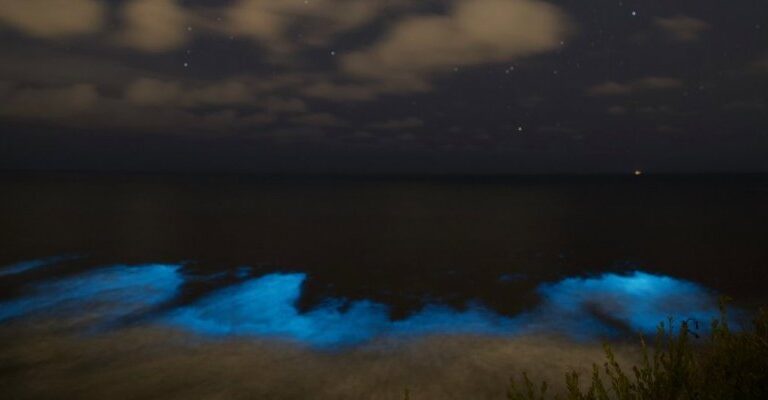
Bioluminescent waves during a red tide event in San Diego County, April 2020. Photo: Nick Sadrpour/CA Sea Grant
The Bright Blue Blooms of Southern California
Springtime in California often brings waves of bright blue blooms across Southern California. Often times these blooms of marine microorganisms capture the spotlight as Southern California residents wonder: what is causing the coastal ocean to look brown-red during the day, and glow iridescent blue at night?
What causes this phenomenon?
The tiny creatures responsible for this phenomenon are bioluminescent microscopic marine algae at the base of the marine food web (phytoplankton). They rapidly increased in large quantities (bloomed) from Los Angeles to Baja California starting in late March, resulting in a red-colored bloom (red tide) and glowing blue waves that are visible at night.
How often do red tide events occur?
Red tide events occur periodically and can last in duration from days to months, often during early spring until late summer. The length of an algal bloom event depends on environmental factors such as temperature, nutrients, sunlight, and ocean circulation.
Why does the water turn blue at night?
While the evolutionary significance of organisms emitting light (bioluminescence) remains debated, in phytoplankton it likely plays a role in predator avoidance. In bioluminescent phytoplankton, the biochemical process that produces light is triggered when water is physically agitated by forces such as waves or swimming. Bioluminescent bloom events are spectacular to witness – it is not every day that our coast is accented by brilliant blue glowing waves.
Are all red tides toxic?
The species responsible for the recent bloom is Lingulodinium polyedrum (within a group of single-celled algae called dinoflagellates) which produces a red photosynthetic pigment responsible for its color. Blooms of some phytoplankton species are considered harmful algal blooms if they produce toxins that can have harmful impacts on wildlife (especially higher-level consumers like marine mammals or birds), or if they reduce oxygen in the water as they decompose, resulting in fish kills. Humans can also be impacted by harmful algal blooms by inhaling irritating aerosols, or by ingesting toxins through recreation or seafood. While L. polyedrum can produce a neurotoxin called yessotoxin, the recent bloom has not been demonstrated to have dangerous effects on humans through swimming or recreation (although some have found aerosols to be irritating) but the bloom has caused fish kills in Orange County and San Diego, especially near lagoons.
What is that smell?
When conditions favorable for blooms diminish, the algae eventually decompose. As algae break down through chemical processes, they release a smell that can often become unpleasant. If you visited the beach within the last month, you may have experienced this smell and may have even seen an overabundance of foam collecting along the edge of waves, another consequence of a decomposing algal bloom.
Do humans have an influence on blooms?
The occurrence of red tides and harmful algal blooms is dependent on environmental conditions including temperature and nutrient concentrations, and therefore can be influenced by human activity. While harmful algal blooms can be viewed as indicators of environmental conditions in our waters and it is important to understand and forecast these occurrences, phytoplankton in general are immensely important for aquatic food webs and ecosystem function. Beyond aquatic ecosystems, they are responsible for producing a large fraction of oxygen in Earth’s atmosphere, supporting life even on land.